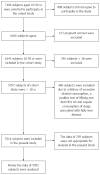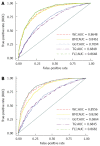Fatty liver index vs waist circumference for predicting non-alcoholic fatty liver disease
- PMID: 26973398
- PMCID: PMC4779925
- DOI: 10.3748/wjg.v22.i10.3023
Fatty liver index vs waist circumference for predicting non-alcoholic fatty liver disease
Abstract
Aim: To determine the discriminatory performance of fatty liver index (FLI) for non-alcoholic fatty liver disease (NAFLD).
Methods: The data of 5052 subjects aged over 18 years were analyzed. FLI was calculated from body mass index, waist circumference (WC), triglyceride, and gamma glutamyl transferase data. Logistic regression analysis was conducted to determine the association between FLI and NAFLD. The discriminatory performance of FLI in the diagnosis of NAFLD was evaluated by receiver operating characteristic analysis. Area under the curves (AUCs) and related confidence intervals were estimated. Optimal cutoff points of FLI in the diagnosis of NAFLD were determined based on the maximum values of Youden's index.
Results: The mean age of men and women in the study population were 44.8 ± 16.8 and 43.78 ± 15.43, respectively (P = 0.0216). The prevalence of NAFLD was 40.1% in men and 44.2% in women (P < 0.0017). FLI was strongly associated with NAFLD, so that even a one unit increase in FLI increased the chance of developing NAFLD by 5.8% (OR = 1.058, 95%CI: 1.054-1.063, P < 0.0001). Although FLI showed good performance in the diagnosis of NAFLD (AUC = 0.8656 (95%CI: 0.8548-0.8764), there was no significant difference with regards to WC (AUC = 0.8533, 95%CI: 0.8419-0.8646). The performance of FLI was not significantly different between men (AUC = 0.8648, 95%CI: 0.8505-0.8791) and women (AUC = 0.8682, 95%CI: 0.8513-0.8851). The highest performance with regards to age was related to the 18-39 age group (AUC = 0.8930, 95%CI: 0.8766-0.9093). The optimal cutoff points of FLI were 46.9 in men (sensitivity = 0.8242, specificity = 0.7687, Youden's index = 0.5929) and 53.8 in women (sensitivity = 0.8233, specificity = 0.7655, Youden's index = 0.5888).
Conclusion: Although FLI had acceptable discriminatory power in the diagnosis of NAFLD, WC was a simpler and more accessible index with a similar performance.
Keywords: Body mass index; Discriminatory performance; Fatty liver index; Non-alcoholic fatty liver disease; Optimal cutoff points; Waist circumference.
Figures


Similar articles
-
Fatty liver index (FLI) and prediction of new cases of non-alcoholic fatty liver disease: A population-based study of northern Iran.Clin Nutr. 2020 Feb;39(2):468-474. doi: 10.1016/j.clnu.2019.02.024. Epub 2019 Mar 18. Clin Nutr. 2020. PMID: 30922791
-
Fatty liver index as a simple predictor of incident diabetes from the KoGES-ARIRANG study.Medicine (Baltimore). 2016 Aug;95(31):e4447. doi: 10.1097/MD.0000000000004447. Medicine (Baltimore). 2016. PMID: 27495073 Free PMC article.
-
Role of Fatty Liver Index and Metabolic Factors in the Prediction of Nonalcoholic Fatty Liver Disease in a Lean Population Receiving Health Checkup.Clin Transl Gastroenterol. 2019 May 22;10(5):1-8. doi: 10.14309/ctg.0000000000000042. Clin Transl Gastroenterol. 2019. PMID: 31082856 Free PMC article.
-
Central obesity and nonalcoholic fatty liver disease risk after adjusting for body mass index.World J Gastroenterol. 2015 Feb 7;21(5):1650-62. doi: 10.3748/wjg.v21.i5.1650. World J Gastroenterol. 2015. PMID: 25663786 Free PMC article. Review.
-
Fatty liver index (FLI): more than a marker of hepatic steatosis.J Physiol Biochem. 2024 Feb;80(1):11-26. doi: 10.1007/s13105-023-00991-z. Epub 2023 Oct 25. J Physiol Biochem. 2024. PMID: 37875710 Review.
Cited by
-
Association between composite dietary antioxidant index and fatty liver index among US adults.Front Nutr. 2024 Oct 16;11:1466807. doi: 10.3389/fnut.2024.1466807. eCollection 2024. Front Nutr. 2024. PMID: 39479196 Free PMC article.
-
The Prevalence of Non-alcoholic Fatty Liver Disease and Diabetes Mellitus in an Iranian Population.Middle East J Dig Dis. 2017 Apr;9(2):86-93. doi: 10.15171/mejdd.2017.56. Middle East J Dig Dis. 2017. PMID: 28638584 Free PMC article.
-
The Association between Educational Attainment and the Risk of Nonalcoholic Fatty Liver Disease among Chinese Adults: Findings from the REACTION Study.Gut Liver. 2024 Jul 15;18(4):719-728. doi: 10.5009/gnl230220. Epub 2024 Feb 22. Gut Liver. 2024. PMID: 38384199 Free PMC article.
-
The Role of the Fatty Liver Index (FLI) in the Management of Non-Alcoholic Fatty Liver Disease: A Systematic Review.Diagnostics (Basel). 2023 Oct 26;13(21):3316. doi: 10.3390/diagnostics13213316. Diagnostics (Basel). 2023. PMID: 37958212 Free PMC article. Review.
-
Validation of fatty liver index as a marker for metabolic dysfunction-associated fatty liver disease.Diabetol Metab Syndr. 2022 Mar 22;14(1):44. doi: 10.1186/s13098-022-00811-2. Diabetol Metab Syndr. 2022. PMID: 35317824 Free PMC article.
References
-
- Angulo P, Lindor KD. Non-alcoholic fatty liver disease. J Gastroenterol Hepatol. 2002;17 Suppl:S186–S190. - PubMed
-
- Neuschwander-Tetri BA, Caldwell SH. Nonalcoholic steatohepatitis: summary of an AASLD Single Topic Conference. Hepatology. 2003;37:1202–1219. - PubMed
-
- Vernon G, Baranova A, Younossi ZM. Systematic review: the epidemiology and natural history of non-alcoholic fatty liver disease and non-alcoholic steatohepatitis in adults. Aliment Pharmacol Ther. 2011;34:274–285. - PubMed
Publication types
MeSH terms
Substances
LinkOut - more resources
Full Text Sources
Other Literature Sources
Medical

